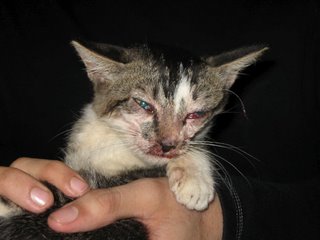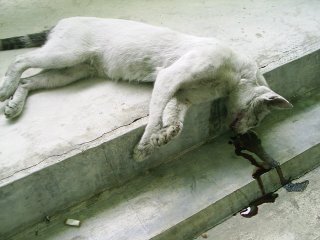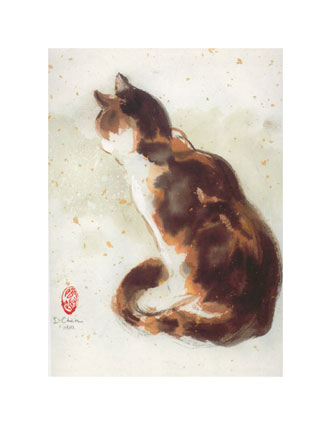Tuesday, July 11, 2006
Monday, July 10, 2006
What prompted me to write about this are the recent failed adoptions & the reasons they fail.
Everyone wants the perfect pet. Who wouldn't? I'd love my Chaos to be perfect so that I don't look the crazy cat lady all the time! Then again, if they are perfect, they wouldn't be Chaos. How boring life at home would be ...
Reality is there's isn't a perfect pet like we know there is no such thing perfect mate. But why do we expect differently from our pets? Simple, they are more disposable & also cheaper to dispose.
If someone goes to a shelter with the mindset to adopt the 'perfect' pet, the minute the pet falls short of expectations, the poor creature gets returned or worse, booted out of the house almost immediately.
Some excuses/reasons given for returnig the pet are pathetic. I don't know about dogs but cats .. tsk tsk tsk. Here's a few.
"The new cat scratched me/hissed at me, my boyfriend, my kid, my resident cat."
Put yourself in the cat's position. All of a sudden, taken away from a familiar surrounding to find itself in a new place with new smell, new noises, new people/cats/kids. Intimidating isn't it? Wouldn't you be a little scared? So why should it be different for a cat. A cat with an abused history is even worse. A foreign hand coming at it suddenly or a loud noise triggers the fear of abuse, prompting the cat to defend itself. & how does the cat defend itself? Hiss & swipe. Its not rocket science, really.
"The new cat can't get along with my cat" (after like 2 days).
Cats are a lot more like humans than most of us care to acknowledge. First time encounters don't necessarily mean love at first sight. The get-to-know stage is usually met with hisses, chasing, swiping & sometimes fighting. That is why, we always suggest separation in the beginning & a slow gradual introduction.
"The new cat just won't use the toilet" or "I want the cat to use the toilet instead of litter"
In short, i'm too cheap to buy litter, so I'm gonna make the cat learn to use the toilet bowl. Reality check - it is less grief to let the cat use the litter box. And no, locking the cat in the toilet isn't going to help either.
Having said that, some cats do have problems learning to use the litter box, despite training & a lot of patience from the owner. Take Wa-Wa for instance, she prefers to toilet to the litter box period. Before you applaud her intelligence, by toilet - I mean the toilet floor not the toilet bowl. But that's just the way it is.
"The cat keeps going to the neighbour's house"
Duh, if you leave the front door wide open. And again to be fair, some cats have the knack to sniff out even the tiniest hole or opening to squeeze through.
As fosterer/rescuer/sponsor, we all wish a happy-ever-after for our cats with their new families. We wish the families give our cats time to adjust to their new surroundings, to get to know them and to love them. We wish they treat their newly adopted cats with love, respect, kindness & compassion.
At the same time we are realistic that some adoption will fail for different reasons. But by treating the new cat carelessly will not improve the situation. In fact, it just creates more stress & fear in the cat.
I personally don't have an issue if the cat is returned because the owner decides the cat is not suitable for them. But I do have an issue when a perfectly healthy, well adjusted cat leaves the shelter & comes back four days later as a sick psycho kitty.
Tuesday, July 04, 2006
"I truly believe that individuals can make a difference in society. Since periods of change such as the present one come so rarely in human history, it is up to each of us to make the best use of our time to help create a happier world."
Monday, July 03, 2006
Stop Cruelty to Animals, Stop the Apathy as Well
But to remain 'bo chap' or belittle it, makes us look like an ungracious, unkind, third world country with little regards for the sanctity of a life of an animal.
Chin Chiu Ngo (Ms)
The Straits Times
July 3, 2006
WITH another case of animal abuse coming to light ('Cat abuser nabbed again for hitting kitten'; ST, June 28), we need to remind ourselves of the importance of being human. On this, two fundamental values come to mind.
First, we have to stop the brutality and unnecessary killing. Yes, we will kill for food and to defend our country and we have the death penalty. But the challenge is to distinguish when killing is necessary and justified and when we should exercise self-restraint.
Deliberate and indiscriminate killing of animals is definitely not justified, and brutality and torture of defenceless animals can only be condemned in the strongest terms.
Indiscriminate culling of cats and birds in housing estates is no less abhorrent to our fundamental values. The issue is sanctity of life and our respect for this sanctity. The authorities need to recognise this and evaluate alternatives rather than embark on another culling exercise.
That some among us can seek out animals with no means of defending themselves for the sole purpose of perpetrating acts of unspeakable cruelty and viciousness is all the more reprehensible and repulsive.
The words humane and humanity are derived from the word human, but given the brutality and unnecessary killing that now seems to be second nature to us, these words may evolve to bear meanings that are the opposite of what we now understand them to be - unless we uphold our fundamental values.
Second, we have to stop the apathy. If we look at these instances of brutality and unnecessary killing taking place in front of us and do nothing, we are no better than the perpetrators. The collective conscience of the public who stood by and watched as others were sent to the gas chambers during the Holocaust is no more clear than that of the Nazis of the Third Reich. We must therefore make a conscious effort to distinguish right from wrong and stop those who indulge in meaningless acts of brutality and indiscriminate killing.
On a personal level, we have a responsibility to teach our children and impress on our friends and neighbours the need to respect the sanctity of life. At the society level, we have to reinforce our fundamental values through legislation and the judicial system.
Only when we can defend our fundamental values and understand the importance of being human can we hope to become the gracious society espoused by the Singapore Kindness Movement.
Black Cat Myths & Superstitions
In western history, black cats have often been looked upon as a symbol of bad omens. One of the prevalent black cat superstition alive in our the western culture today is if a black cat crosses your path, it is considered bad luck. Interesting, in most other cultures, the black cat is a prized possession & owning one, is said to bring the owner good luck.
The origin of the black cat & good luck is said to have begun in Ancient Egypt with the sacred black cat of BAST. BAST is a official deity of Egypt in the 22nd dynasty. During her reign, Egyptians courted her favours, by keeping black cats into their houses, believing that she would become part of the cat in spirit & grace their home with riches & prosperity.
Charles I of England (1600 – 1649) owned a black cat. He loved the cat so much so that he had guards protecting the cat 24 hours a day, until one day the cat fell in & died. Charles I was heard to proclaim – “alas my luck is gone.” True enough, he was arrested the next day & charged with high treason. He was later put to his death.
In Sumatra, during a long drought, a black cat is found and thrown into the river. The village folk would line the bank, forcing the cat to swim until almost exhausted. Once the cat is exhausted they allow the cat to get out of the water. The women of the village then chase the black cat while throwing water on the cat and themselves. This is supposed to bring rain. Although this tradition might bring good luck to the village, pity the poor cat that has the bad luck of being chosen for this!
In the Yorkshires, a black cat was said to bring the fishermen home safely from the seas. During the most prominent part of the fishing industry in this village, black kittens were often catnapped and sold to the highest bidder (usually the wives of the fishermen) by racketeers trying to cash in on the popular superstition.
In parts of Europe, if a black cat crosses your path, you are considered to have good fortune. If a black cat walks into your house or home, you are truly blessed. But in the United States, the term Black Cat was used by the fishermen and sailors of Michigan’s Lake Superior for a boat that was believed to have a spell cast upon it and therefore, never will carry a full crew.
The attitude towards black cats is said to change sometime around the pilgrims arriving at Plymouth Rock. The pilgrims were devout Christians & they were deeply suspicious of anything deemed of the devil. Comprised of Englanders & Europeans, these pilgrims viewed black cat as a companion or a familiar to witches. Anyone caught with a black cat would be severely punished or even killed. They viewed the black cat as part demon and part sorcery.
When the Christians gained a foothold in America they also propelled this myth forward, during a time when witches were coming into fruition in America. Sharing a sisterhood with witches in England, and rumored to use black cats as an integral part of their craft. Black cats were suddenly cast into a bad light many black cats were sought after and killed. If a farmer believed his land had a spell cast upon it, the only way to break that spell was to shoot a black cat with a silver bullet.
Ask anyone what comes to mind when black cat is mentioned and cat lovers will inevitably say: mysterious, alluring, beautiful, playful, elegant and gorgeous. But non-cat owners would come up with: bad luck, witches familiar, evil, demonic, mean, spooky and Halloween... So you can see the superstition lives on even today.
Here's more superstitions from all around the world. Some are good & some, not necessarily so:
- A black seen from behind fortells a bad omen – Unknown
- A strange black cat on your porch brings prosperity – Scottish
- A black cat crossing one’s path by moonlight means death in an epidemic – Irish
- A black cats carry demons – Unknown
- If a black cat walks towards you, it brings good fortune, but if it walks away, it take the good fortune with it.
- It is believed that if a black lived in the house, the young las would have plenty of suitors (woohoo!) – English
- It is believed that if you find one white hair on a black cat, Lady Luck will smile upon you (double woohoo! Dawa has 4, the last time I counted!) – French
- While it is lucky to own a black cat, it is extremely unlucky to come across one accidentally – English
- It is considered bad luck to pass a black cat at 9pm
- It is thought that a reincarnated soul may be ‘liberated’ by throwing a black cat into a fire – Indian
- Women could change their soul into a black cat & that any harm brought to the cat would be suffered by the women – Bengali
- It is thought that black cats were reincarnated being able to divine the future – Celtic
- It is believed that if a black cat jumped on the bed of a sick person it meant death is near – German
- It is thought that black cats were thought to carry the souls of the dead to the other world – Finnish
- It is thought that the presence of a black cat foretold of poverty – Chinese
What on Earth is Dawa?



I should have explained the meaning Dawa's name.
Translated literally in Mandrain, Dawa would meaning simply Big Doll.
But it is actually a Tibetan name which could mean Monday. But it has a much symbolic meaning to it - "the one who brings light out of the darkness".
But I suspect Dawa just prefers Wa-Wa (doll in short). She pretends not to hear me when Dawa is called & meows when I called Wa-Wa *sigh*
So there it is - Dawa is her name & Wa-Wa shall be her nickname.
:)
Saturday, July 01, 2006
U.S. Bill Aimed at Research Trade
Activists target dealers who collect animals-- including, some say, stolen pets--for sale to science facilities
By Marni Goldberg
Washington Bureau
Published June 30, 2006
He calls it the "blood belt."
Chris DeRose uses that phrase to describe 15 sites, stretching from Oklahoma to Pennsylvania, where dogs and cats gathered from random sources are sold for research. DeRose, president of the non-profit animal welfare group Last Chance for Animals, says dealers at these sites even steal pets from ordinary homes.
His organization has conducted undercover investigations of so-called Class B animal dealers, which are certified by the U.S. Department of Agriculture to collect animals from flea markets and pounds, among other places, and sell them to research facilities. Last Chance and like-minded groups say the animals are mistreated. But their most incendiary charge is that Class B dealers regularly steal pets from homes and sell them to research facilities for hundreds of dollars.
"Anyone whose animal is missing shouldn't have to stay up at night wondering if their animal ended up in a lab," said Cathy Liss, legislative director for the Society for Animal Protective Legislation.
According to those in the research community, the idea that pets are being stolen from back yards is ludicrous and the allegations of animal welfare activists represent another attempt to turn the public against animal research.
But activists have been heard on Capitol Hill, where the Pet Safety and Protection Act is again pending in both houses of Congress. The act would prohibit Class B dealers from selling random-source dogs and cats to laboratories.
Proponents of the act, which has not passed Congress in previous attempts, insist the legislation has a chance this time, crediting the added momentum to a recent HBO documentary.
HBO's "Dealing Dogs" documents practices at Martin Creek Kennels, an Arkansas facility that was owned and operated by C.C. Baird, a Class B dealer. An undercover investigator from Last Chance worked at Martin Creek for six months.
Stephanie Loranger of Washington now owns Skittles, a terrier mix who was rescued from Martin Creek Kennels, which the USDA charged with more than 100 counts of animal abuse and neglect.
"Since we got her home she's learned how to be loved," Loranger said of Skittles. "She's got some problems still from being in that place for so long."
Should the legislation pass, research facilities would have to rely on Class A dealers who breed and raise animals themselves. According to the USDA, of the 92,475 dogs and cats used in research in 2002--the latest year for which figures are available--about 70 percent came from Class A dealers. Of the remaining 30 percent, two-thirds --about 18,500 cats and dogs--came from Class B dealers, and the rest came from other sources.
Dogs shot, corpses in heaps.
The legislation would allow research institutions to continue breeding animals and, in states where it is still legal, pounds could release animals to research facilities with the consent of the owners who turned in their pets.
Rep. Mike Doyle (D-Pa.) is co-sponsoring the House bill with Rep. Phil English (R-Pa.).
"You couldn't watch ["Dealing Dogs"] for any more than 5 to 10 minutes and not be convinced that the only way to solve this problem is put Class B dealers out of business," Doyle said.
The documentary depicts graphic images, including dogs being held to the ground and shot, dead animals being tossed into heaps, and trenches full of decaying bodies of dogs.
"As upsetting as it may be, please understand that what we go through watching [the film] is nothing compared to what these animals go through," said "Pete," the investigator who surreptitiously filmed the images in the documentary.
In 2003, Last Chance gave its footage to federal officials, leading to a raid of Martin Creek Kennels. The USDA then charged Baird with animal abuse and neglect, and he was ordered to pay a $262,700 civil penalty, the largest ever for violations of the Animal Welfare Act. Baird's Class B license was permanently revoked. In addition, Baird and his wife pleaded guilty last August to felony charges in a mail fraud scheme related to the sale of dogs and cats to research facilities. Their sentencing is scheduled for July 14.
"Pete," in a hat and sunglasses to conceal his identity, was at a Capitol Hill luncheon for congressional staffers this month where "Dealing Dogs" was shown to generate support for the bill.
The USDA inspects Class B facilities as part of its enforcement responsibility under the Animal Welfare Act, passed in 1966 to establish minimum standards of care and treatment required for certain animals used in research. According to the USDA, Class B dealers are subject to at least one unannounced inspection yearly.
The animal law was amended in 1990 in an effort to prevent lost and stolen pets from ending up at Class B facilities. The change required that pounds hold animals for at least five days before turning them over to dealers and that dealers be able to provide paperwork that connects each animal from a random source to its original owner.
According to activists, the USDA does not have the capacity to adequately regulate these dealers. While rules are in place, documentation is regularly falsified and records are not adequately checked, resulting in lost and stolen pets becoming research subjects, critics contend.
Researchers: Thefts a myth.
Researchers, however, label claims of pet thefts a myth. Amanda Banks of the California Biomedical Research Association said there is no evidence to support the claim that pets are being stolen by Class B dealers. Instead, she says there is good evidence that pets are being stolen for fighting.
Banks added that researchers are concerned about the perception "in the general public's mind that animals are acquired inappropriately for animal research. That doesn't happen."
Some also say the claims from animal rights activists, and the potential elimination of Class B dealers, could hurt animal research.
Statistically, dogs and cats constitute a low percentage of animals used in research. According to 2004 USDA figures, dogs and cats constituted 8 percent of the 1,101,958 research subjects. The majority were rodents.
Animal rights activists say that preventing Class B dealers from selling dogs and cats from random sources thus would not have an impact on the work of the research community. They add that some research facilities have already stopped using Class B dealers.
But biomedical research advocates say random source animals sold by these Class B dealers, or released to research facilities from pounds, serve a purpose.
"While we mostly don't use Class B animals now, we don't know what the future of animal research will require," Banks said. "We don't want to close doors not knowing what's in the future."
Chaos is Back to 5
Chaos welcome their newest addition, Dawa.
She is a gorgeous kitten with shiny black coat. It is obvious she is abandoned as she has the sweetest disposition of all Chaos & very obedient. She is about 7 months old, about the age of Junior. So far, they’re getting along famously, chasing each other up & down the highway of Chaos House, driving Beauty literally out the window.
Following the lead of Junior, she accepts free lick baths from Alex & hisses at Carma.
:)

live a vulnerable life, as long as abusers like David Hooi & the S.O.B. of Old Airport Road (the elusive anonymous abuser) unremain at large.

The recent kitten that was killed by David Hooi

Another victim of the Old Airport Road abuser

Another abuse story
But, there is a bigger problem besides catching the abusers. And that is, dealing with the government authority - AVA & the town councils.
13,000 cats are killed each year by the AVA "in their efforts to keep the neighourhood clean & promote harmonious living". This works out to approximately 35 cats (healthy, sick, young & old) are rounded up every day to be culled.
Dawn from the Cat Welfare Society made a poignant point in her blog entry "An even bigger crime than abuse" - while actions of the likes of Hooi cannot be condoned, neither should culling.
But how do we make the authorities (AVA, town councils & the management committees) understand that culling is NOT the solution to control the stray cat population? TNR is. How do we make them and the public understand the benefits TNR brings to the cats & the community?
In August 1998, AVA started the Stray Cat Rehabilitation Scheme in its efforts to find humane and effective ways to control the stray cat population in housing estates. The aim is to encourage dedicated and committed volunteer animal caregivers to work with town councils to control the cat population over the long-term through sterilisation and responsible management of the cats. There were 140 areas registered on the scheme involving all the town councils.
Unfortunately when the SARS epidemic hit Singapore in 2003, there was an island-wide panic. The scheme stopped & the culling began again. Now how convince we get the authorities that the Stray Cat Rehabilitation Scheme worked & it should be re-instated?
Also, equally important, how do we educate and convince the public of the importance of responsible pet ownership?
Lastly how do we encourage people to stand up to bullies like Hooi & the S.O.B. & report them so that these bullies know they can't get away with murder? And that we, the society, are watching their every move?
Until we find answers to these questions, this is a picture of the statue dedicated to our beautiful kucintas (Singapore cats) that die undeservingly each & every day.

Kucintas under the Cavenagh Bridge







